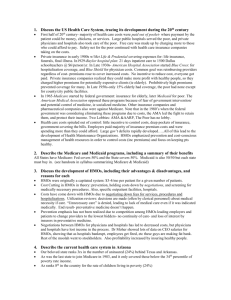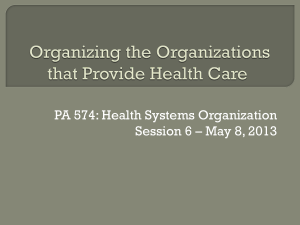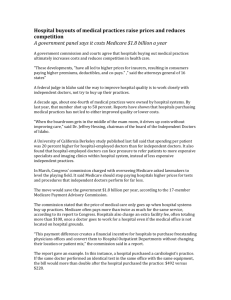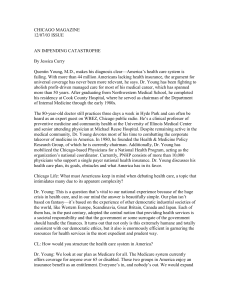Midterm Exam Answer Key
advertisement
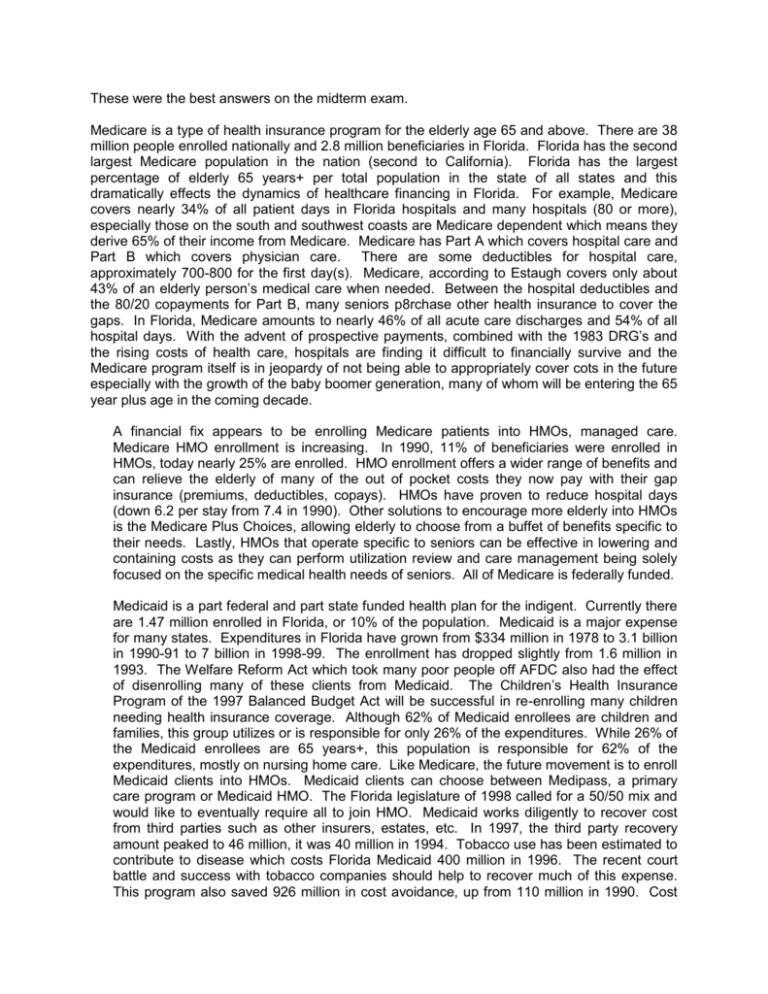
These were the best answers on the midterm exam. Medicare is a type of health insurance program for the elderly age 65 and above. There are 38 million people enrolled nationally and 2.8 million beneficiaries in Florida. Florida has the second largest Medicare population in the nation (second to California). Florida has the largest percentage of elderly 65 years+ per total population in the state of all states and this dramatically effects the dynamics of healthcare financing in Florida. For example, Medicare covers nearly 34% of all patient days in Florida hospitals and many hospitals (80 or more), especially those on the south and southwest coasts are Medicare dependent which means they derive 65% of their income from Medicare. Medicare has Part A which covers hospital care and Part B which covers physician care. There are some deductibles for hospital care, approximately 700-800 for the first day(s). Medicare, according to Estaugh covers only about 43% of an elderly person’s medical care when needed. Between the hospital deductibles and the 80/20 copayments for Part B, many seniors p8rchase other health insurance to cover the gaps. In Florida, Medicare amounts to nearly 46% of all acute care discharges and 54% of all hospital days. With the advent of prospective payments, combined with the 1983 DRG’s and the rising costs of health care, hospitals are finding it difficult to financially survive and the Medicare program itself is in jeopardy of not being able to appropriately cover cots in the future especially with the growth of the baby boomer generation, many of whom will be entering the 65 year plus age in the coming decade. A financial fix appears to be enrolling Medicare patients into HMOs, managed care. Medicare HMO enrollment is increasing. In 1990, 11% of beneficiaries were enrolled in HMOs, today nearly 25% are enrolled. HMO enrollment offers a wider range of benefits and can relieve the elderly of many of the out of pocket costs they now pay with their gap insurance (premiums, deductibles, copays). HMOs have proven to reduce hospital days (down 6.2 per stay from 7.4 in 1990). Other solutions to encourage more elderly into HMOs is the Medicare Plus Choices, allowing elderly to choose from a buffet of benefits specific to their needs. Lastly, HMOs that operate specific to seniors can be effective in lowering and containing costs as they can perform utilization review and care management being solely focused on the specific medical health needs of seniors. All of Medicare is federally funded. Medicaid is a part federal and part state funded health plan for the indigent. Currently there are 1.47 million enrolled in Florida, or 10% of the population. Medicaid is a major expense for many states. Expenditures in Florida have grown from $334 million in 1978 to 3.1 billion in 1990-91 to 7 billion in 1998-99. The enrollment has dropped slightly from 1.6 million in 1993. The Welfare Reform Act which took many poor people off AFDC also had the effect of disenrolling many of these clients from Medicaid. The Children’s Health Insurance Program of the 1997 Balanced Budget Act will be successful in re-enrolling many children needing health insurance coverage. Although 62% of Medicaid enrollees are children and families, this group utilizes or is responsible for only 26% of the expenditures. While 26% of the Medicaid enrollees are 65 years+, this population is responsible for 62% of the expenditures, mostly on nursing home care. Like Medicare, the future movement is to enroll Medicaid clients into HMOs. Medicaid clients can choose between Medipass, a primary care program or Medicaid HMO. The Florida legislature of 1998 called for a 50/50 mix and would like to eventually require all to join HMO. Medicaid works diligently to recover cost from third parties such as other insurers, estates, etc. In 1997, the third party recovery amount peaked to 46 million, it was 40 million in 1994. Tobacco use has been estimated to contribute to disease which costs Florida Medicaid 400 million in 1996. The recent court battle and success with tobacco companies should help to recover much of this expense. This program also saved 926 million in cost avoidance, up from 110 million in 1990. Cost avoidance is aimed at trying not to pay until perhaps other insurance or other sources will. The BBA 1997 will place Medicaid nursing facilities on a prospective payment basis, holding down these large expenses (62% of all for age 65+). Costs and expenses may rise in the future as a result of children gaining and regaining coverage but children are relatively inexpensive and much disease and disability can be prevented with good primary care for them and other Medicaid clients enrolling in managed care. Physicians control 85% of all health care expenditures and their payments are the second largest expense next to hospitals in the health care system. Doctors have a great deal of professional authority and autonomy and medical authority to order tests, require follow up visits, admit patients to hospitals and other facilities and to prescribe drugs. In the past, the financial incentives for doctors were to order, admit and prescribe without external limits as they were paid fee for services and could set charges. In the past two decades, doctors have been scrutinized by managed care. Many have felt that their professional and medical authority has been impeded upon. Today, many are paid by capitation which is a set predetermined dollar amount per patient per month for a twelve month period, or whatever the contract period may be. Managed care organizations have implemented utilization review techniques and peer reviews to monitor the practice behavior of doctors. Those who are shown to overutilize, over refer to specialists, etc., may face losing their contracts with the HMOs. In the future, consumers may lose choice volume regarding their primary care doctors as HMOs will find managing costs and care easier and more financially successful with a group of fewer, yet cost conscious doctors. Currently, there is a glut of specialists and a disproportionately fewer primary care doctors, 30% of all MDs in Florida are primary care. Geographic maldistributions also are evident. Rural areas have less access to both types of doctors. There are approximately 40,000 MDs in Florida and 645,000 nationally. The greatest increase of Doctors was seen in medical surgical specialists and an increase in all specialists, a 28% increase since 1990 compared to a 10% increase in primary care doctors. The government predicts we will only need 140 specialist MDs/1000,000 by 2010, yet it looks as if there might be 183/100,000. The government can pay teaching med. schools and hospitals not to train MDs (in contrast to paying $70,000 a year for each resident in training) and can restrict the influx of foreign med. school graduates. Managed care will force doctors to change their practice behaviors. One technique being considered besides RBVS ( paying according to time, judgment skill of a procedure) would be to implement Total Risk Capitation which would be to pay MD’s based on a global budget, giving them a set dollar amount per patient per year and putting all the risk in their court. This is a sort of prospective payment mechanism which puts expenditure limits on the doctor and could force behavior change. Doctors who do not wish to comply will chance losing privileges with the HMOs. Doctors have been banding together to protect their ever rising incomes and their autonomy. Solo practice will become a thing of the past. Many are joining groups and the future will see them in large networks together. This gives them better negotiating clout and makes the ever increasing administrative costs and day to day tasks of information processing easier for all in the network. Although some MD groups have tired to offer their own insurance by joining with hospitals, this has proven difficult for them to manage and to put up the required capital to satisfy the Department of Insurance. Physician practice management firms are not doing well lately for these reasons and for the fact that they have investors to satisfy. Practicing medicine, as MDs are finding, is easier for them than managing policy and insurance risk. The future may hold that we see a reverse in the trends among specialists vs. primary care. As more Americans including Medicare and Medicaid beneficiaries become HMO members, more primary care doctors will be needed, not just to be gatekeepers but to really practice preventive medicine which will help to slow health care cost inflation. Hospitals are the largest expense of the health care industry, 35% of all expenditures. The industry is comprised of a variety of different types of facilities including nonprofit, private for profit and nonprofit, tax exempt for profit and multihospital systems, and public not for profit. With the rising costs of health care expected to soon reach 1.3 trillion, up from billions in the 1980’s, hospitals have been the one sector to experience the effects of cost containing measures. With the advent of Diagnostically Related Groups in 1993 from the Medicare program (max cost assigned to specific procedures), hospitals have had to try all measures to contain costs, including moving patients out of the hospital sooner (patient days have dropped for the 65 and under population by 12% while outpatient services grew 40% since 1990). Average stays and costs per stay have also decreased. Hospital (census?) use to be in the 80% range (daily beds occupied). Today, census rates are in the mid 50’s range. Florida has 26,000 empty beds. All of the cost containment efforts from DRGs to restricted allowable care by HMOs and the restricted payments placed by Medicare and Medicaid have forced many small, nonprofit and private small for profit hospitals to close. The trend is toward regional multihospital systems. As Estaugh makes the analogy, these multi hospitals systems are like Walmart. They are good at providing the service at lowest cost better than smaller chains. They become powerful financially with investors and investments which earn revenue. They are also good at marketing to consumers (i.e., pretty birthing and family centers). They pay a great deal more in Federal tax (500 billion avg), than smaller nonprofit yet they also take less indigent care. In Florida, there are a combination of different types of hospitals but 75% are multihospital system hospitals. Particularly the big ones Columbia, Tenet Adventist and Bay Care. Florida has 219 acute care hospitals. While managed care has resulted in reduced patient days, and lowered census, and the trend for hospitals to merge into multihospitals systems, all hospitals are impacted by such restrictions as prospective payment by Medicare and Medicaid. In Florida, 47% of all hospital revenues are from Medicaid. Some hospitals are Medicaid dependent, 80 on the Southwest coast and in south Florida where there is a large concentration of elderly. Recent data shows hospital revenues up 19% while expenses grew 17% in 1998. All hospitals have to be very cost careful. Those nonprofit public hospitals that care for the bulk of the uninsured in Florida. There are 3 million uninsured in Florida which as cost 940 billion in hospital care. The multihospital systems claim that they pay high Federal tax to offset their lack of “case sharing” for the indigent. Fortunately in Florida, most hospital admissions are for the elderly. However, with 8 million Hispanics and other uninsured immigrants, Florida does have a greater rate of uncompensated care, 7.3% of all expenditures vs. 6.1% nationally. Physicians are crucial to hospitals as they order admissions. MDs have had to shorten patient stays. In order to recoup costs they have increased the intensity of care during these shortened stays. However, with disease management plans and other UR techniques, Medicare and managed care will limit these clever techniques for increasing revenues. Some doctors and hospitals have together and separately (competitively too) gotten into the business of outpatient care. Both are realizing this is more revenue producing than inpatient care. There are 4.5 million HMO members in Florida. There are 39 plans vs. 650 nationally. The different types are: staff HMOs in which physicians are salaried by the plan, network HMOs which are a combination of staff and group HMOs, group HMOs are HMOs in which the organization contracts with a group of physicians. Also, there are preferred provider HMOs were patients can go to specialists but have to pay 20% copay. HMOs provide subscribers with a broad set of benefits in a defined period of time in exchange for a premium which is set for usually 12 months. Indemnity plans operate on a fee for service and while they offer beneficiaries much more freedom of MD choice including specialists, they are more expensive. There is usually an 80/20 deductible and charges for hospital and MD services to indemnity plan patients are usually higher than for HMO patients. HMOs attempt to contain costs by selective contacting with only cost containing MDs (those that keep utilization in check, keep it down), and offering discounts to these doctors, costs are also kept down by requiring copayments for doctors visits and drug prescriptions. These copayments as well as premium may very well be rising in the near future as HMOs have lost 10% revenue in the last year. Due mostly to the market being saturated (membership enrollment nearing its maximum). HMOs would like to raise premiums but large employer groups and the Department of Insurance combine to disallow this. HMOs can restrict choice of doctors, particularly specialists, and certain types of care (i.e., going to out of area cancer specialists for treatment) are not allowed. Over all though, patients receive a broad array of benefits including eye exams, mammograms and other preventive health care. Emphasis on preventive health care will also increase as a cost inflation prevention. The leading causes of death/disability, heart disease, cancer, stroke, diabetes and asthma, are very costly. Many of these can be managed with prevention to reduce costs. HMOs face financial danger unless they can manage costs and utilization even better in the future. Consumers are placing a great deal of pressure on HMOs for less premiums, more freedom to go to specialists, more prescription drugs, and more tests (diagnostic). The primary source of revenues is patient premium. By restricting utilization and reducing volume (while at the same time keeping demanding consumers happy), HMOs are in for some difficult times. Like hospitals, small HMOs will be closing and large HMOs, though less of them, will be the norm in the future. Long term health care in the US consists of nursing home care, home health care and recently, community care retirement centers and life care centers as well as adult congregate living facilities. The majority of the industry is for profit, with 385,000 nursing home beds for profit owned by multihospital systems and 62,000 beds freestanding for profit versus 240,000 nonprofit beds. There are a total of 900,000 beds nationally. There are 71,000 beds in Florida, 2% of which are owned by for profit hospitals. Like the nation, most Florida beds are owned by private chains. Occupancy rates in Florida nursing homes has risen to 73% in 1998 from 52% in 1996. Medicare pays for a limited time and if a person does not have adequate financial resources, Medicaid pays (62% of all Medicaid expenses in Florida). Hospitals have shortened the LOS for elderly and discharged more and more to nursing homes, placing patients with great medical needs into these beds. At one time a lucrative business, nursing homes are beginning to fell the effects of the BBA 1197, with prospective payment systems. The industry which one reaped billions is now under scrutiny from Medicaid. Home health care has seen an increase in business as it cares for many who cannot afford nursing homes. However, with restrictions from Medicare and Medicaid, it too is beginning to suffer financially. Forty-eight home health care businesses closed in Florida in 1998-99. The nation is witnessing a growth in the aging population. Financing long term care as the people now age 50-64 grow (in Florida 14% of the population to 21% in 2010), long term care financing will be difficult for Medicaid to continue with. Many early retirees and baby boomers fail to consider financial planning for their long-term care needs. Too many (even current elderly) are surprised to find out that Medicare coverage for long term care is so very limited. Many more people will be living to 85+ with a 60% chance of being in a nursing home 5 years or more. The long-term care industry dilemma poses a few questions. Should long term care be an integral part of the health care system? Should people plan to use their own financial resources? Only 2% of the 50+ age group have purchased long term care insurance. Who is responsible? Who will regulate it? Florida, with its large elderly population will surely set an example. We have to work on these questions today while other states deal with other issues. Perhaps only the wealthy will be able to afford community care centers. We may end up with a range of quality long-term care centers analogous to Hilton Hotels all the way down to Motel 6’s. The trend does seem to be away from skilled nursing home care to a variety of community care. Some will specialize for Alzheimer’s patients, stroke and cardiovascular patients.
